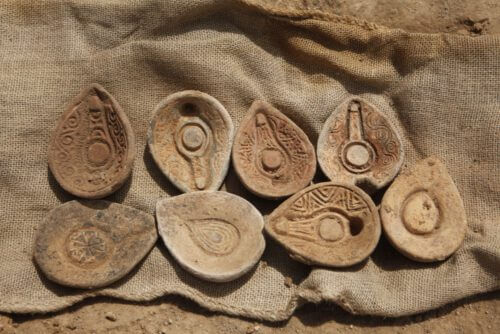A rare hoard from the early Islamic period was discovered in an excavation on behalf of the Institute of Archeology at the Hebrew University of Jerusalem, led by Dr. Oren Gutfeld. Ten molds of oil candles that have survived in their entirety, made of clay and decorated with geometric and plant patterns, allow a rare glimpse of working bicycles in ancient times

An array of rare items in size, quality and completeness were recently discovered in Tiberias as part of an archaeological dig conducted by Dr. Oren Gutfeld, Michal Haber and Tal Rogovski from the Institute of Archeology of the Hebrew University of Jerusalem, as well as with the assistance of the Antiquities Authority. The excavation was conducted at a site considered to be a residential neighborhood from the early Islamic period (more precisely, the Umayyad, Abbasid and Fatimid periods, from the middle of the 7th century AD to the middle of the 11th century AD), with most of the findings on the site dating from this period. The excavation revealed, among other things, many construction remains including residential buildings, but mainly various facilities, water canals and furnaces that were used for light industry, and especially for the production of oil candles made of clay. About 500 m south of this site was found about 20 years ago, by Dr. Gutfeld and the late Prof. Yizhar Hirschfeld, also from the Institute of Archeology at the Hebrew University, The largest hoard of Islamic metalware in the world, currently displayed in the Israel Museum.
A rare cache of its kind
The highlight of the excavation findings is A rare cache of ten oil candle molds that survived in their entirety (as well as many fragments of similar molds), made of clay and decorated with various geometric and plant patterns. Also, many oil candles were found in the excavation, it seems that at least some of them were not used, which indicates the presence of a manufacturing house in the place. One of the candles, by the way, was found to match one of the patterns. Another impressive find is an engraving of the name "Allah" in Arabic on one of the molds. In addition, a five-pointed star was drawn on one of the templates, similar in shape to the Star of David (however, the template should not be linked to a menorah).
In the 11th century AD, the Land of Israel was hit by earthquakes one after the other, in a sequence that caused loss of life and property. Some of the earthquakes were so huge that they were felt, according to many historians, from Syria to Egypt. As far as we know, heavy damage was caused to buildings in Tiberias, and evidence of this can be seen in the field, at the site where Dr. Gutfeld, Haber and Rogovsky worked. According to them, an avalanche of items discovered in the area reinforces the assumption that Tiberias did not return to settlement after the severe earthquakes of the same century, and that all the inhabitants of the site and its surroundings moved north, to live in the Crusader city of Tiberias.
Dr. Gutfeld: "The findings discovered in the excavation area revealed a unique fabric of life that combines a residential neighborhood with industry. In addition to the molds, the oil candles and the furnace, five septic tanks were also discovered that were used as toilets and a built well that goes down to the level of the Sea of Galilee to a depth of about 3.5 m. Based on an avalanche of architectural items found around the well, mainly small columns and capitals, it appears that the well was in the center of a courtyard decorated with beautiful stone items. The landslide was excavated and it seems that it is an impressive testimony to the earthquake of 1033 in which Tiberias was destroyed.'
After undergoing conservation processes in the Israel Museum's laboratories, the oil candles and molds will be shown for the first time to the general public at the museum during Hanukkah. The closeness of time between the discoveries in the archaeological dig last summer and the presentation of these findings in the museum, allows the general public to enjoy exhibits that have just been discovered and it usually takes a long time for them to be revealed to the public.
Liza Luria, curator of the exhibition for Islamic art and archeology at the Israel Museum, summarizes: "The tools that will be displayed make it possible to trace the process of creating pottery in molds - from the mold stage, through which the material takes the shape of the intended tool and its characteristic decoration system, through the firing of the tools in a dedicated kiln, and up to the stage of the finished tool, which corresponds to the mold through which it was created. Discoveries of this type constitute a rare glimpse into work processes in our region in ancient times. The presentation of the findings in the Israel Museum makes it possible to examine and study traditional forms of work with local characteristics, a concept that is becoming relevant again today, with a renewed revival of movements that seek to develop and promote design and work patterns that draw from local work methods from the past."
